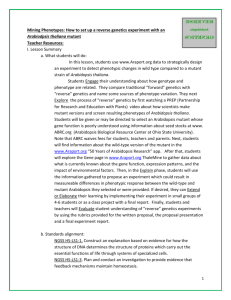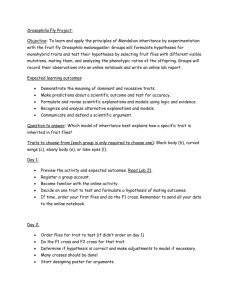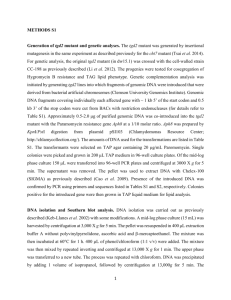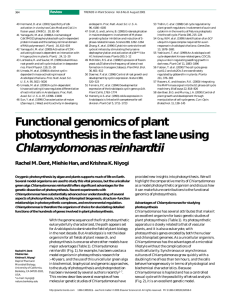tpj13060-sup-0017-Legends
advertisement
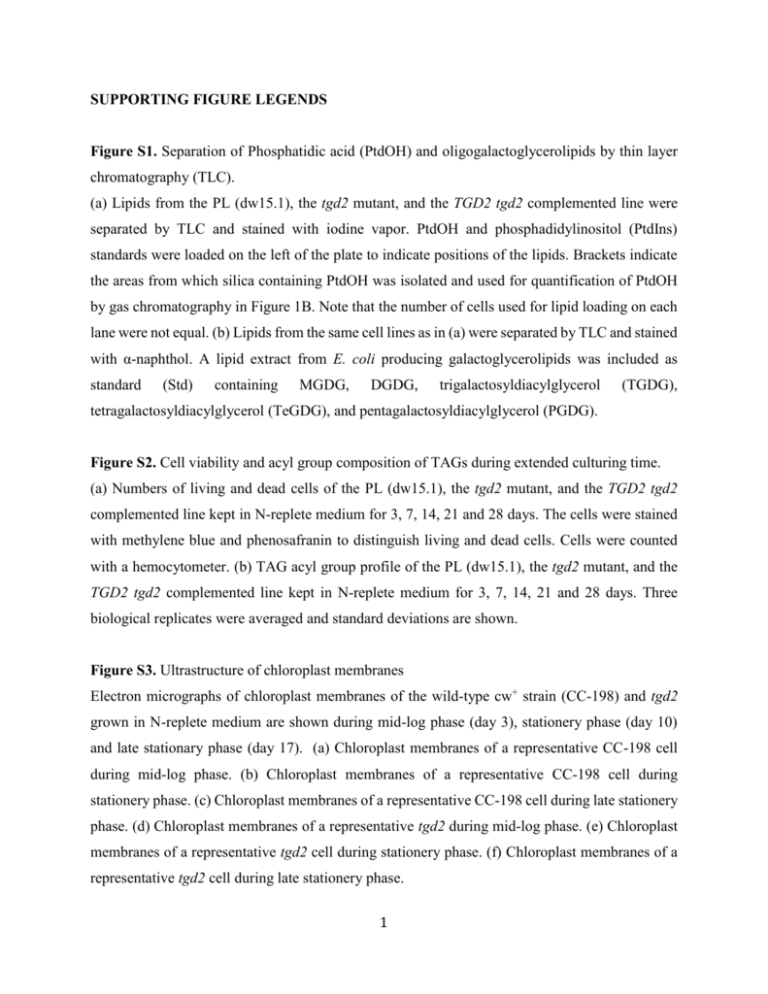
SUPPORTING FIGURE LEGENDS Figure S1. Separation of Phosphatidic acid (PtdOH) and oligogalactoglycerolipids by thin layer chromatography (TLC). (a) Lipids from the PL (dw15.1), the tgd2 mutant, and the TGD2 tgd2 complemented line were separated by TLC and stained with iodine vapor. PtdOH and phosphadidylinositol (PtdIns) standards were loaded on the left of the plate to indicate positions of the lipids. Brackets indicate the areas from which silica containing PtdOH was isolated and used for quantification of PtdOH by gas chromatography in Figure 1B. Note that the number of cells used for lipid loading on each lane were not equal. (b) Lipids from the same cell lines as in (a) were separated by TLC and stained with α-naphthol. A lipid extract from E. coli producing galactoglycerolipids was included as standard (Std) containing MGDG, DGDG, trigalactosyldiacylglycerol (TGDG), tetragalactosyldiacylglycerol (TeGDG), and pentagalactosyldiacylglycerol (PGDG). Figure S2. Cell viability and acyl group composition of TAGs during extended culturing time. (a) Numbers of living and dead cells of the PL (dw15.1), the tgd2 mutant, and the TGD2 tgd2 complemented line kept in N-replete medium for 3, 7, 14, 21 and 28 days. The cells were stained with methylene blue and phenosafranin to distinguish living and dead cells. Cells were counted with a hemocytometer. (b) TAG acyl group profile of the PL (dw15.1), the tgd2 mutant, and the TGD2 tgd2 complemented line kept in N-replete medium for 3, 7, 14, 21 and 28 days. Three biological replicates were averaged and standard deviations are shown. Figure S3. Ultrastructure of chloroplast membranes Electron micrographs of chloroplast membranes of the wild-type cw+ strain (CC-198) and tgd2 grown in N-replete medium are shown during mid-log phase (day 3), stationery phase (day 10) and late stationary phase (day 17). (a) Chloroplast membranes of a representative CC-198 cell during mid-log phase. (b) Chloroplast membranes of a representative CC-198 cell during stationery phase. (c) Chloroplast membranes of a representative CC-198 cell during late stationery phase. (d) Chloroplast membranes of a representative tgd2 during mid-log phase. (e) Chloroplast membranes of a representative tgd2 cell during stationery phase. (f) Chloroplast membranes of a representative tgd2 cell during late stationery phase. 1 Figure S4. Southern blot analysis of the tgd2 mutant and the PL (dw15.1). Genomic DNA was restriction digested with BamHI. Linearized pHyg3 plasmid was used as a control. The probe was complementary to a fragment from the pHyg3 plasmid (see Methods). A line between tgd2 and pHyg3 plasmid indicates different exposure times of the same blot. Figure S5. Analysis of progeny from crosses between tgd2 and CC-198. (a) TAG content of the PLs (dw15.1) and (CC-198), the original tgd2 mutant in the dw15.1 background, and progenies from 6 zygotes with HS indicating Hygromycin B-sensitive and HR Hygromycin B-resistant progenies. (b) TAG acyl group profiles of the same lines as described under (a). Figure S6. Mutant locus in the tgd2 genome and complementation. (a) Alignment of tgd2 assembled contigs with chromosome 16 of the Chlamydomonas reference genome (v5.3). The Aph7 gene insertion, affected genes and their annotation are shown. (b) Cellular TAG concentrations of parental line (PL, dw15.1), tgd2 mutant, CrTGD2 complemented lines (C1-C3) and empty vector control (EV). (c) TAG acyl groups (16:0, 16:4 and 18:3) of the same lines as described under (b). (b, c) Three replicates were averaged and standard deviations are shown. (d) Cultures (30 day-old) of the PL (dw15.1), the tgd2 mutant and transgenic lines into which the six deleted genes were individually introduced into the tgd2 mutant. Three independent lines per gene introduced are shown. (e) Cellular PtdOH concentrations of the PL, the tgd2 mutant and CrTGD2 complemented lines (TGD2 tgd2, C3). Figure S7. Amino acid sequence alignment of AtTGD2 and CrTGD2. The alignment shows transmembrane and Mammalian Cell Entry (MCE) domains. The alignment was carried out with MUSCLE (3.8). Figure S8. Phylogenetic analysis of CrTGD2 homologues. The evolutionary history was inferred based on Maximum Likelihood. The tree with the highest log likelihood (-4302.1023) is shown. The percentage of trees in which the associated taxa clustered together (1000 repeats) is shown above the branches. The tree is drawn to scale, with branch lengths corresponding to the number of substitutions per site. The accession number for 2 each protein is given in the parenthesis following the scientific name. Accession numbers for Chlamydomonas, Arabidopsis and other organisms are from the Joint Genome Institute (JGI), the Arabidopsis Information Resource (TAIR), and National Center for Biotechnology Information (NCBI), respectively. Groups of organisms are shown as colored bars. Figure S9. Lack of Arabidopsis TGD2 complementation in Chlamydomonas tgd2 mutant. (a) CrAtTGD2-pSI103 construct. Genomic DNA of Chlamydomonas TGD2 (CrTGD2) containing promoter region, intron, transit peptide and transmembrane domain (TMD) was assembled with codon optimized Arabidopsis TGD2 (AtTGD2) membrane extrinsic portion, followed by Chlamydomonas genomic DNA containing the terminator of CrTGD2. The assembled sequence was cloned into pSI103-AphVIII containing the AphVIII Paromomycin resistance gene. (b) Western blot analysis of CrAtTGD2 protein expression in the tgd2 mutant background (AtTGD2 tgd2). Arabidopsis TGD2 recombinant protein (AtTGD2) was used as a positive control. White lines separate irrelevant lanes removed from the blot. (c) TAG concentration (fmol/cell) of the PL, the tgd2 mutant, the empty vector control in tgd2 mutant background (EV), and AtTGD2 tgd2 line 1-4. Figure S10. Lack of Chlamydomonas TGD2 complementation in Arabidopsis tgd2 mutant. (a) AtCrTGD2-pMDC32 construct. Genomic DNA of Arabidopsis TGD2 (AtTGD2) containing transit peptide and transmembrane domain (TMD) was assembled with Chlamydomonas TGD2 (CrTGD2) transmembrane extrinsic portion. The assembled sequence was cloned into pMDC32 containing 2x35S promoter and nos terminator. (b) Western blot analysis of AtCrTGD2 fusion protein expression in the Arabidopsis tgd2 mutant background (AtCrTGD2 tgd2) line 2, 6, 10, 15 and 20 compared to Col-2, tgd2-1 and the AtTGD2 cDNA complemented line (AtTGD2 tgd2-1). (c) TLC plate separating oligogalactoglycerolipids shows trigalactosyldiacylglycerol (TGDG) and tetragalactosyldiacylglycerol (TeGDG) of Arabidopsis lines as shown in (b). (d) Acyl group composition of monogalactosyldiacylglycerol (MGDG) of lines in (b). (e) Acyl group composition of digalactosyldiacylglycerol (DGDG) of lines in (b). 3 Figure S11. Pulse chase [14C]-acetate labeling of MGDG in the PL (dw15.1). Replicates from four independent experiments during a 0-9 h chase are shown. The highest radioactivity incorporations were set as 1, while the lowest were set as 0. Table S1. Bacterial Artificial Chromosomes (BACs) used in the tgd2 complementation analysis. Corresponding BAC identifiers from the Joint Genome Institute (JGI) and from the Clemson University Genomics Institute (CUGI) are shown. Restriction endonucleases used for isolating genomic DNA fragments containing individual genes and corresponding product sizes are shown. The amount of genomic DNA and that of the Aph8 gene used for transformation as well as names of primers used for testing the insertion are listed. The primer sequences are given in Table S2. Table S2. Sequences of primers for probing the deletion in chromosome 16 of the tgd2 mutant. Table S3. Sequences of primers used for constructing plasmids as indicated. Methods S1. All supporting methods. DATA S1. Amino acid sequence alignment of Mammalian Cell Entry domains of CrTGD2 homologues used for building the phylogenetic tree in Supplemental Figure 7. 4



